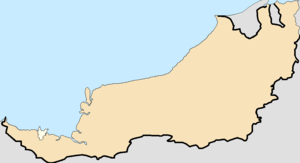Kuching
Kuching (/ˈkuːtʃɪŋ/), officially the City of Kuching,[7] is the capital and the most populous city in the state of Sarawak in Malaysia.[8] It is also the capital of Kuching Division. The city is situated on the Sarawak River at the southwest tip of the state of Sarawak on the island of Borneo and covers an area of 431 square kilometres (166 sq mi) with a population about 165,642 in the Kuching North administrative region and 159,490 in the Kuching South administrative region[9][10][11]—a total of 325,132 people.[9]
Kuching | |
|---|---|
City and state capital | |
| City of Kuching Bandar Raya Kuching (Standard Malay) | |
| Other transcription(s) | |
| • Jawi | کوچيڠ |
| • Chinese | 古晉 |
| • Tamil | கூச்சிங் |
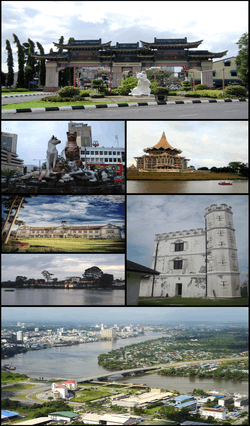 Clockwise from top right: Chinatown, State Assembly building, Fort Margherita, Pending Bridge, The Astana, Sarawak State Museum and cat statues. | |
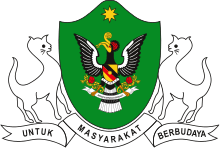 Commission of the City of Kuching North 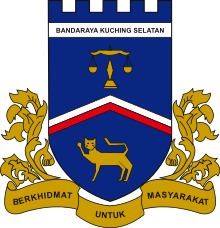 Council of the City of Kuching South | |
| Nickname(s): "Cat City", Bandaraya Perpaduan (City of Unity) | |
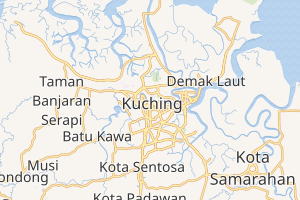
Location of Kuching in Sarawak | |
| Coordinates: 01°33′40″N 110°20′30″E | |
| Country | |
| State | |
| Division | Kuching |
| District | Kuching District |
| Founded by the Sultanate of Brunei | 1827 |
| Settled by James Brooke | 18 August 1842 |
| Granted municipality status | 1 January 1953 |
| Granted city status | 1 August 1988 |
| Government | |
| • Mayor of Kuching North | Abang Wahap Abang Julai |
| • Mayor of Kuching South | James Chan Khay Syn |
| Area | |
| • City of Kuching | 431.02 km2 (166.42 sq mi) |
| • Metro | 2,030.94 km2 (784.15 sq mi) |
| • Kuching North | 369.48 km2 (142.66 sq mi) |
| • Kuching South | 61.54 km2 (23.76 sq mi) |
| Sourced from the DBKU official website | |
| Elevation | 8 m (26 ft) |
| Highest elevation | 810.2 m (2,658.1 ft) |
| Lowest elevation | 0 m (0 ft) |
| Population (2019)[5] | |
| • City of Kuching | 570,407 |
| • Density | 754.33/km2 (1,953.7/sq mi) |
| • Metro | 684,112 |
| • Metro density | 336.8/km2 (872/sq mi) |
| • Demonym | Kuchingite / Orang Kuching |
| Sourced from Population and Housing Census of Malaysia 2010. Kuching metropolitan area (Greater Kuching) includes population of 358,980 in the Padawan municipality and Samarahan district.[6] | |
| Time zone | UTC+8 (MST) |
| • Summer (DST) | UTC+8 (Not observed) |
| Postal code | 93xxx |
| Area code(s) | 082 (landline only) |
| Vehicle registration | QA and QK (for all vehicles except taxis) HQ (for taxis only) |
| Website | Kuching North: www Kuching South: www |
Kuching was the third capital of Sarawak in 1827 during the administration of the Bruneian Empire. In 1841, Kuching became the capital of the Kingdom of Sarawak after the territory in the area was ceded to James Brooke for helping the Bruneian empire in crushing a rebellion particularly by the interior Borneo dweller Land Dayak people who later became his loyal followers after most of them being pardoned by him and joining his side. The town continued to receive attention and development during the rule of Charles Brooke such as the construction of a sanitation system, hospital, prison, fort, and a bazaar. In 1941, the Brooke administration had a Centenary Celebration in Kuching. During World War II, Kuching was occupied by Japanese forces from 1942 to 1945. The Japanese government set up a Batu Lintang camp near Kuching to hold prisoners of war and civilian internees. After the war, the town survived intact. However, the last Rajah of Sarawak, Sir Charles Vyner Brooke decided to cede Sarawak as part of British Crown Colony in 1946. Kuching remained as capital during the Crown Colony period. After the formation of Malaysia in 1963, Kuching retained its status as state capital and was granted city status in 1988. Since then, the Kuching city is divided into two administrative regions managed by two separate local authorities. The administrative centre of Sarawak state government is located at Wisma Bapa Malaysia, Kuching.
Kuching is a major food destination for tourists and the main gateway for travellers visiting Sarawak and Borneo.[12] Kuching Wetlands National Park is located about 30 kilometres (19 mi) from the city and there are many other tourist attractions in and around Kuching such as Bako National Park, Semenggoh Wildlife Centre, Rainforest World Music Festival (RWMF), state assembly building, The Astana, Fort Margherita, Kuching Cat Museum, and Sarawak State Museum. The city has become one of the major industrial and commercial centres in East Malaysia.[13][14]
Etymology
The name "Kuching" was already in use for the city by the time Brooke arrived in 1841.[10][15] There are many theories as to the derivation of the name "Kuching". It was perhaps derived from the Malay word for cat, "kucing" or from Cochin, an Indian trading port on the Malabar Coast and a generic term in China and British India for trading harbour.[10] Some Hindu artefacts can be seen today at the Sarawak State Museum.[16] However, another source reported that the Kuching city was previously known as "Sarawak" before Brooke arrived. The settlement was renamed to "Sarawak proper" during the kingdom expansion. It was only in 1872 that Charles Brooke renamed the settlement to "Kuching".[16][17]
There was one unlikely theory based on a story on miscommunication. According to the story, James Brooke arrived in Kuching on his yacht Royalist. He then asked his local guide about the name of the town. The local guide mistakenly thought that Brooke was pointing towards a cat, and so had said the word "Kuching". However, ethnic Malays in Sarawak have always used the term "pusak" for cats (cognate with Filipino pusa), instead of the standard Malay word "kucing".[16] Despite this etymological discrepancy, Sarawakians have adopted the animal as a symbol of their city.
Some source also stated that it was derived from a fruit called "mata kucing" (Euphoria malaiense),[note 1][note 2] a fruit that grows widely in Malaysia and Indonesia.[18] There was also a hill in the city that was named after the fruit, which is called Bukit Mata Kuching. A British woman writing to her son in the 19th century, stated that the name was derived from a stream of the same name, called "Sungai Kuching" or Cat River in English.[10][19] On page 64 of Bampfylde and Baring-Gould's 1909 'A History of Sarawak under its Two White Rajahs', it says: "Kuching, the capital of Sarawak, is so called from a small stream that runs through the town into the main river...." The stream was situated at the foot of Bukit Mata Kuching and in front of the Tua Pek Kong Temple. In the 1950s, the river became very shallow because of silt deposits in the river. The river was later filled to make way for roads.[16]
There is another theory that Kuching actually means "Ku" (古)- Old and "Ching"(井) - Well or "old well" (古井) in Chinese. During the Brooke administration, there was no water supply and water-borne diseases were common. In 1888, an epidemic broke out which later was known as "Great Cholera Epidemic". A well situated in the present day China Street in Main Bazaar helped to combat the disease by providing clean water supply. Due to increased demand for a water supply, the role of the well was later replaced by water treatment plant on the Bau Road.[16][20]
History
Sarawak was part of the Bruneian Empire since the reign of first Brunei sultanate, Sultan Muhammad Shah. Kuching was the third capital of Sarawak, founded in 1827 by the representative of the Sultan of Brunei, Pengiran Indera Mahkota.[21] Prior to the founding of Kuching, the two past capitals of Sarawak were Santubong, founded by Sultan Pengiran Tengah in 1599, and Lidah Tanah, founded by Datu Patinggi Ali in the early 1820s.[21]
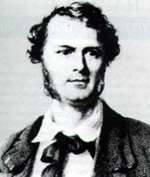
Pengiran Raja Muda Hashimit later ceded the territory to a British adventurer, James Brooke as a reward for helping him to counter a rebellion.[22] The rebellion was crushed in November 1840, and on 24 September 1841, Brooke was appointed as the Governor of Sarawak with the title of Rajah.[22] It was not announced until 18 August 1842, following Sultan Omar Ali Saifuddin II's ratifying the governorship, and requiring Brooke to pay an annual sum of $2,500 to the Sultan.[22] Since that time, Kuching became the seat of the Brooke government.[23]

_BHL40563162_(cropped).jpg)
The administration was later continued by his nephew, Charles Brooke. As an administrative capital, it became the centre of attention and development.[15] Improvements included a sanitation system.[15] By 1874, the city had completed several developments, including construction of a hospital, prison, Fort Margherita, and many other buildings.[15]
Charles Brooke's wife write his autobiography, (My Life in Sarawak), including his descriptions of Kuching:
The little town looked so neat and fresh and prosperous under the careful jurisdiction of the Rajah and his officers, that it reminded me of a box of painted toys kept scrupulously clean by a child. The Bazaar runs for some distance along the banks of river, and this quarter of the town is inhabited almost entirely by Chinese traders, with the exception of one or two Hindoo shops....Groceries of exotic kinds are laid out on tables near the pavement, from which the purchasers make their choice. At the Hindoo shops you can buy silks from India, sarongs from Java, tea from China and tiles and porcelain from all parts of the world, laid out in picturesque confusion, and overflowing into the street.[15][24]
The Astana (Palace), which is now the official residence of the Governor of Sarawak, was constructed next to Brooke's first residence. He had it built in 1869 as a wedding gift to his wife.[25][26] Kuching continued to prosper under Charles Vyner Brooke, who succeeded his father as the Third Rajah of Sarawak.[22] In 1941, Kuching was the site of the Brooke Government Centenary Celebration.[27] A few months later, the Brooke administration came to a close when the Japanese occupied Sarawak.[22]
During the Second World War, six platoons of infantry from 2/15 Punjab Regiment were stationed at Kuching in April 1941.[28] The Regiment defended Kuching and Bukit Stabar airfield from being the destroyed by the Japanese.[28] Defence was mainly concentrated on Kuching and Miri.[28] However, on 24 December 1941, Kuching was conquered by the Japanese forces. Sarawak was ruled as part of the Japanese Empire for three years and eight months, until the official Japanese surrender on 11 September 1945. The official surrender was signed on HMAS Kapunda at Kuching.[29][30][31] From March 1942, the Japanese operated the Batu Lintang camp, for POWs and civilian internees, 5 kilometres (3.1 mi) outside Kuching.[32]
After the end of World War II, the town survived and was wholly undamaged.[33] The third and last Rajah, Sir Charles Vyner Brooke later ceded Sarawak to the British Crown on 1 July 1946.[34][35] During the Crown Colony period, the government worked to develop and improve the infrastructure on Sarawak.[30] Kuching was revitalised as the capital of Sarawak under the British colonial government.[36] When Sarawak, together with North Borneo, Singapore and the Federation of Malaya, formed the Federation of Malaysia in 1963,[37] Kuching kept its status as the state capital and was granted a city status on 1 August 1988.[38][39] Kuching experienced further development throughout the years as the state capital. On 29 July 2015, Kuching was declared as "City of Unity" by One Malaysia Foundation for racial harmony that existed in the city because of cross-racial marriages, multi-racial schools, fair scholarship distributions, and balanced workforce patterns.[40][41]
Governance
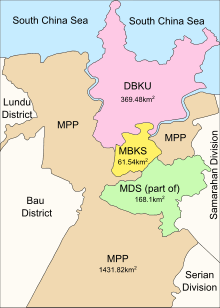
As a capital of Sarawak, Kuching plays an important role in the political and economic welfare of the population of the entire state as it became the seat of the state government where almost all of their ministries and agencies are based. The Sarawak State Legislative Assembly is located at the suburb of Kuching in Petra Jaya.
There are 5 Members of Parliament (MPs) representing the five parliamentary constituencies and twelve state legisative assemblyman in the state legislature representing twelve state constituencies in Kuching district.
| Parliamentary Constituencies | State Constituencies |
|---|---|
| P.193 Santubong | N.3 Tanjung Datu (within Lundu district), N.4 Pantai Damai, N.5 Demak Laut |
| P.194 Petra Jaya | N.6 Tupong, N.7 Samariang, N.8 Satok |
| P.195 Bandar Kuching | N.9 Padungan, N.10 Pending, N.11 Batu Lintang |
| P.196 Stampin | N.12 Kota Sentosa, N.13 Batu Kitang, N.14 Batu Kawah |
| P.198 Puncak Borneo | N.18 Serembu (within Bau district), N.19 Mambong, N.20 Tarat (within Serian Division) |
Local authority and city definition
Kuching is the only city in Malaysia to be administered by two mayors,[21] the city is divided into Kuching North and Kuching South.[42] Each of these is administered by a mayor for Kuching South and commissioner for Kuching North.[14] The current commissioner for Kuching North is Datuk Abang Wahap Abang Julai, who took over from Abang Atei Abang Medaan on 1 August 2011 while Dato' James Chan Khay Syn became the new mayor for the Kuching South in 2008 after the sudden death of Chong Ted Tsiung.[43][44] The city obtained a city status on 1 August 1988,[38] and since that it was administered by Kuching North City Hall (DBKU) and Kuching South City Council (MBKS).
The city is defined within the borders of what is the Kuching District, formerly the Municipality of Kuching. With an area of 1,868.83 square kilometres, it is the most populous district in Sarawak.[45] The area then subdivided into three sub-districts, namely Kuching Proper, Padawan, and Siburan. Kuching Proper included the city area and Padawan municipality, while Siburan and Padawan[note 3] is a sub-district. The combined area of Kuching North City Hall, Kuching South City Council, Padawan Municipal Council, and the Samarahan District Council is known as Greater Kuching.[1][46]
Geography
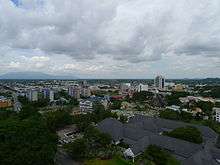
Kuching is located on the banks of the Sarawak River in the northwestern part of the island of Borneo.[47] The limits of the City of Kuching include all that area in Kuching District containing an area approximately 431.01 square kilometres (166.41 sq mi) bounded from Gunung Lasak (Mount Lasak) in Muara Tebas to Batu Buaya (Crocodile Rock) in the Santubong peninsula following a series of survey marks as stated in the First Schedule of the City of Kuching Ordinance, 1988.[7] As a simplification of the legal statute, the Kuching city limits extend from the Kuching International Airport in the south to the northern coast of the Santubong and Bako peninsulas; from the Kuching Wetlands National Park in the west to the Kuap River estuary in the east.[7] The Sarawak River generally splits the city into North and South. The highest point in the city is Mount Santubong on the Santubong peninsula, which is at 810.2 metres (2,658 ft) above sea level, located 35 km north of the city centre.[4] Rapid urbanisation has occurred in Greater Kuching and the urban sprawl extends to Penrissen, Kota Sentosa, Kota Padawan, Batu Kawah, Matang, Samariang, Siburan, Tarat, Kota Samarahan, Asajaya as well as Serian which is located about 65 km from Kuching.
Climate
Kuching has a tropical rainforest climate (Köppen climate classification Af), moderately hot but very humid at times and receives substantial rainfall.[48] The average annual rainfall is approximately 4,200 millimetres (170 in).[49] Kuching is the wettest populated area (on average) in Malaysia with an average of 247 rainy days per year. Kuching receives only 5 hours of sunshine per day on average and an average of only 3.7 hours of sunshine per day in the month of January (wettest month of the year).[50] The wettest times are during the North-East Monsoon months of November to February and the city's driest months are June through August. The temperature in Kuching ranges from 19 °C (66 °F) to 36 °C (97 °F) but the average temperature is around 23 °C (73 °F) in the early hours of the morning and rises to around 33 °C (91 °F) during mid afternoon but the heat index often reaches 42 °C (108 °F) during the "dry season" due to the humidity.[51] This temperature stays almost constant throughout the year if it is not affected by the heavy rain and strong winds during the early hours of the morning which can bring the temperature down to 19 °C (66 °F), but this is very rare.[48]
| Climate data for Kuching (1971–2000, extremes 1876–present) | |||||||||||||
|---|---|---|---|---|---|---|---|---|---|---|---|---|---|
| Month | Jan | Feb | Mar | Apr | May | Jun | Jul | Aug | Sep | Oct | Nov | Dec | Year |
| Record high °C (°F) | 34.6 (94.3) |
34.7 (94.5) |
35.2 (95.4) |
36.1 (97.0) |
36.0 (96.8) |
35.6 (96.1) |
36.1 (97.0) |
36.4 (97.5) |
36.5 (97.7) |
35.2 (95.4) |
34.8 (94.6) |
34.7 (94.5) |
36.5 (97.7) |
| Average high °C (°F) | 29.8 (85.6) |
30.2 (86.4) |
31.3 (88.3) |
32.3 (90.1) |
32.7 (90.9) |
32.7 (90.9) |
32.4 (90.3) |
32.4 (90.3) |
32.0 (89.6) |
31.9 (89.4) |
31.6 (88.9) |
30.6 (87.1) |
31.7 (89.1) |
| Average low °C (°F) | 22.9 (73.2) |
23.0 (73.4) |
23.2 (73.8) |
23.4 (74.1) |
23.6 (74.5) |
23.3 (73.9) |
23.0 (73.4) |
23.0 (73.4) |
22.9 (73.2) |
22.9 (73.2) |
22.9 (73.2) |
22.9 (73.2) |
23.1 (73.6) |
| Record low °C (°F) | 17.8 (64.0) |
18.9 (66.0) |
18.3 (64.9) |
20.0 (68.0) |
20.6 (69.1) |
18.9 (66.0) |
19.4 (66.9) |
19.4 (66.9) |
19.3 (66.7) |
20.5 (68.9) |
20.0 (68.0) |
18.9 (66.0) |
17.8 (64.0) |
| Average rainfall mm (inches) | 684.1 (26.93) |
473.3 (18.63) |
338.6 (13.33) |
272.9 (10.74) |
241.8 (9.52) |
220.3 (8.67) |
185.6 (7.31) |
229.6 (9.04) |
262.3 (10.33) |
338.6 (13.33) |
371.5 (14.63) |
498.1 (19.61) |
4,116.7 (162.07) |
| Average rainy days (≥ 1.0 mm) | 22 | 17 | 16 | 17 | 15 | 14 | 13 | 14 | 16 | 19 | 22 | 22 | 207 |
| Average relative humidity (%) | 89 | 88 | 86 | 86 | 86 | 84 | 83 | 83 | 85 | 86 | 88 | 89 | 86 |
| Mean monthly sunshine hours | 109.5 | 108.5 | 135.5 | 162.1 | 188.8 | 188.9 | 192.9 | 171.4 | 147.1 | 147.1 | 142.9 | 125.9 | 1,820.6 |
| Source 1: World Meteorological Organisation[52] | |||||||||||||
| Source 2: NOAA (sun, 1961–1990),[53] Meteo Climat (record highs and lows),[54] Deutscher Wetterdienst (humidity, 1975–1985)[55] | |||||||||||||
Demography
The terms "Kuchingite" have been used to describe the people of Kuching, although it is not official.[25] However, the simplest way to call the people of Kuching is only by "orang Kuching", which means "people of Kuching" in English.
Ethnicity
The Malaysian Census 2010 reports that Kuching has a population of 325,132.[9] The city population (North and South) consists of Malays (146,580), Chinese (120,860), Iban (28,691), Bidayuh (13,681), Non-Malaysian citizens (7,216), other Sarawak Bumiputras (Orang Ulu) (3,250), Melanau (2,078), Indian (1,626) and others (1,140).[6] The Chinese are made up of Hokkien in the city areas and Hakka in the suburbs mainly.[56] Other Chinese subgroups consist of Foochow, Hainanese, Teochew, Cantonese, and Henghua.
The Iban, Bidayuh, Dayak and Orang Ulu are mainly Christian, with some still practising Animism, while the Chinese practise either Buddhism, Taoism or Christianity while the most of the Malays and Melanau are Muslim. A number of Hindus, Sikhs and a small number of secularists also exist around the city.
There is a sizeable number of non-citizens, who mostly come from the bordering Indonesian region of Kalimantan, most of whom are migrant workers.[57][58] Since the British period, a small population of South Asian especially Pakistanis have exist around the city by running their business mainly in selling clothes and spices.[59] Other migrants who came during the time included Bugis from the Dutch East Indies and other races from the neighbour Dutch Borneo.[60] Interracial marriages among those of different ethnic backgrounds are common in Kuching, and the city itself is a home to 30 different ethnic groups.[61][62]
- Religious sites in Kuching
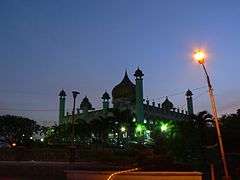 Kuching Mosque at dusk
Kuching Mosque at dusk Hong San Si Temple
Hong San Si Temple St. Joseph Cathedral
St. Joseph Cathedral
Languages
Beside being the capital city of Sarawak, Kuching became a business and cultural centre for the Malays of Sarawak.[63] The dialect of Malay spoken in Kuching is known as Bahasa Sarawak (Sarawakian Malay Language), which is a subset of the Malay language.[64] The dialect used in Kuching is a little different from the dialect used in Miri.[64] Since the second largest population in the city is made up of Han Chinese, the Chinese language is also commonly used, particularly Hokkien, Hakka, and Mandarin Chinese.[65] Almost all residents are able to speak English.[66] A number of special private schools that teach English for expatriates child can be found through the city.[67]
Economy
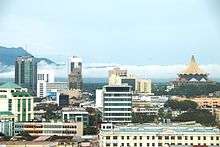
Kuching is one of the main industrial and commercial centres for Sarawak. Many state-level, national-level, and international commercial banks, as well as some insurance companies establish their headquarters and branches here. The economy is dominated by the primary sector and currently by the tertiary-based industry as the state government wants to aim Sarawak to be transformed into a developed state by 2020.[14][68][69]
There are 3 industrial areas in Kuching, namely Pending Industrial Estate (Mixed and Light Industries), Demak Laut Industrial Park (Mixed, Light, and Medium Industries), and Sama Jaya Free Industrial Zone (Hi-Tech and electronics industry).[70] This is intended to boost the city's commercial and industrial activity to making it a major growth centre in East Malaysia, as well for the BIMP-EAGA (Brunei-Indonesia-Malaysia-Philippines East ASEAN Growth Area).[69] Kuching hosted numerous national, regional and international conferences, congress, and trade fairs, such as the Malaysia Global Business Forum,[71] Tomorrow's Leaders Summit,[72] International Hydropower Association (IHA) World Congress,[73] ASEAN Tourism Forum,[74] and Routes Asia Conference.[75] Besides, Kuching was chosen as a permanent host for the biennial Asean International Film Festival and Awards (AIFFA).[76] These events are normally held at the Borneo Convention Centre.
Kuching Port Authority (KPA), established in 1961, started its operation at Tanah Puteh Port (Sim Kheng Hong Port) in 1975 with annual capacity of 350,000 tonnes. Its operations has since been shifted to Pending and Senari terminals with annual capacity of 2.9 million tonnes and 7 million tonnes respectively. KPA also controls Biawak Oil Jetty that handles petroleum products.[77][78][79]
Historically, the Chinese have contributed to the city economy since their migration during the Brunei Sultanate period after the discovery of antimony ore and also during the Charles Vyner Brooke administration who encouraged the migration of the overseas Chinese to planting black pepper.[10]
Transport
Land
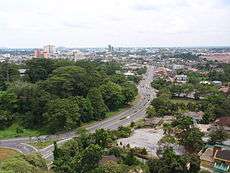
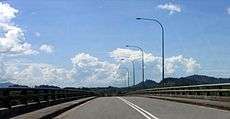
Roads in the city are under the jurisdiction and maintenance of either the two local councils, i.e. DBKU (Dewan Bandaraya Kuching Utara) and MBKS (Majlis Bandaraya Kuching Selatan), or the state's Public Works Department. Roads of the latter category are either state roads or federal roads.
Most major internal roads are dual-carriageways and the city is linked by roads to other towns in Sarawak. These roads are mainly federal roads maintained by the national Public Works Department. The city also famous for a number of roundabouts including the oldest and largest one, known as Datuk Abang Kipali Bin Abang Akip Roundabout.[80] The roundabout are usually landscaped and were efficient to handling traffic congestion.[80][81] However, traffic lights are more commonly used now as the city traffic continues to rise.
As the city is located near the equator, potholes have the tendency to develop on the roads during the monsoon season, usually at the end of the year due to coinciding with winter in the Northern Hemisphere. Roads leading outside of the city to the interior are of a slightly lower quality but are now being upgraded.[82] Highway routes from Kuching include:
- 1–15 Kuching–Serian Highway

- Kuching–Kota Samarahan Expressway

- Matang Highway
Public transport
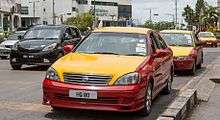
There are two types of taxi operating in the city, the main taxi is the red and yellow while the larger is painted in blue, which is more comfortable but expensive known as the "executive taxis".[83] In 2014, a smartphone taxi booking application named "GrabTaxi" was launched and making the city as the fifth area after Klang Valley, Cyberjaya, Putrajaya, and Johor Bahru that have the applications.[84] The main bus terminal is the Kuching Sentral, which just launched in 2012.[85] It is located in the south of the city, about 5 minutes away from the Kuching International Airport and 20 minutes from the city centre.[86] The terminal serves a long-distance destination to Brunei, Sabah, and West Kalimantan in Indonesia.[87] Another bus terminal is the Old Kuching Bus Terminal, it is still operating as some of the bus companies that supposed to use the new terminal are unwilling to use the facilities due to some ongoing disagreement.[88] Other minibuses or vans services also available in the city.
Water
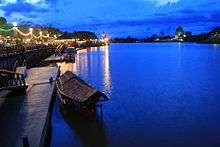
Kuching, like most towns in Sarawak, has connections to other urban centres and settlements by water transport. Between the banks of the Sarawak River, near the city centre, many 'tambang' (traditional roofed wooden sampan) can be seen carrying passengers from one riverbank to another.[42][89] For those staying along the river banks, it is a short way to getting to the city-proper. The wharf for express boats servicing transport to further areas such as Sibu and Bintulu, is located in the east of the city at the Sim Kheng Hong Port (formerly known as the Tanah Puteh Port) in Pending.[90][91]
Air
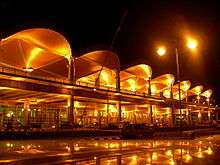
Kuching International Airport (KCH) (ICAO Code : WBGG) is the main gateway for air passengers. The airport's history dates back to the 1940s and today the airport has undergoing many major redevelopment.[92] The airport terminal is listed as the fourth busiest airport in Malaysia according to total passenger movements in 2013.[93] Since 2009, the airport has grown rapidly with an increasing number of passengers and aircraft movement. It is the secondary hub for Malaysia Airlines[94] and AirAsia[95] while became the third hub for MASWings,[96] which serves flights to smaller towns and rural areas in East Malaysia.
Other utilities
Courts of law and legal enforcement
The current court complex is located in Petra Jaya.[97][98] It contains the High Court, Sessions Court, and the Magistrate Court.[99] Another courts of Syariah and native were also located in the city.[100][101] The Sarawak Police Contingent Headquarters is located in Badruddin Street.[102] There is only one district headquarters in the city, which is the Kuching District police headquarters located in Simpang Tiga Road.[103][104] Kuching Prison Complex is located in Puncak Borneo Street.[105] Temporary lock-ups or prison cells are found in most police stations around the city.
Healthcare
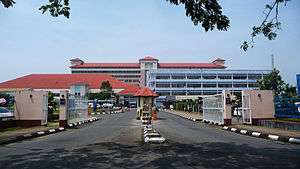
There are many types of health services in the city, such as the main public hospitals, public health clinics, other type of health clinics, mobile clinic, flying doctor service, village clinics, and 1Malaysia clinic.[106] The main hospital is the Sarawak General Hospital which is the oldest hospital since 1923. Another hospital is Rajah Charles Brooke Memorial Hospital.[107] Hospital Sentosa (Sentosa Mental Hospital), was opened in 1958, it provides psychiatric services for the entire state and known as the second oldest hospital in Sarawak after the main hospital.[108]
Normah Medical Specialist Centre in Petra Jaya is the largest private hospital with (130 beds) in Sarawak.[109] In addition, three other large private health facilities are Borneo Medical Centre with (120 beds),[110] Timberland Medical Centre with (100 beds),[111] and KPJ Healthcare with (75 beds).[112] Kuching Specialist Hospital located in BDC is schedule to open its operation to the public in 2020, with a 70-bed capacity.
Education
In the city, all schools under the National Education System (government education institution category), are managed by the Kuching Combined Education Office (Pejabat Pelajaran Gabungan Kuching). There are many government or state schools in and around the city. Like other Malaysian schools, schools in the city are divided into four levels of education — pre-school, primary, secondary (lower and upper) and post-secondary (excluding tertiary). Among the well-established and prestigious boarding schools in the city is Sekolah Menengah Sains Kuching, which is located at Batu Kawa and Sekolah Menengah Sains Kuching Utara, which is located at Matang Jaya.[113] Other govermernment secondary schools including some of the oldest and well known are SMK St. Joseph, SMK St. Thomas, SMK St. Teresa and SMK St. Mary as well as others like SMK Greenroad, Kolej Datu Patinggi Abang Haji Abdillah, SMK Tun Abang Haji Openg, SMK Batu Lintang, and SMK Padungan.[113] Kuching has 4 out of 14 Chinese independent schools in Sarawak. These are Chung Hua Middle School No. 1 (古晋中华第一中学), Chung Hua Middle School No. 3 (古晋中华第三中学), Chung Hua Middle School No. 4 (古晋中华第四中学) and Batu Kawa Min Lit secondary school (石角民立中学).[114] There are also two international schools in Kuching namely Tunku Putra International School[115] and Lodge International School.[116] Other private schools in Kuching are Sunny Hill School[117] and St Joseph Private Schools.[118]
There are currently no public university campuses in Kuching, apart from the Universiti Malaysia Sarawak (UNIMAS) Faculty of Medicine and Health Sciences building situated next to the Sarawak General Hospital. The Sarawak state government moved the last remaining public university campus (Universiti Teknologi MARA) from Kuching to Kota Samarahan in 1997 in a long-term initiative to transform Kota Samarahan into an education hub.[119] Kuching is home to three private universities: the Swinburne University of Technology Sarawak Campus, the only branch campus of Swinburne University of Technology outside Australia; Executive College; and UCSI University, Sarawak Campus which houses the Faculty of Hospitality and Management. A polytechnic and community college, both known as Politeknik Kuching Sarawak and Kolej Komuniti Kuching are also located in the city.
Other private colleges can be found through the city with most of the colleges are subsidiaries from universities and university colleges established in West Malaysia, such as SEGi College, Sarawak, Sunway College Kuching, Limkokwing Borneo, PTPL Sarawak, Wawasan Open University, Open University Malaysia, and Twintech College Sarawak. There are private institutions conducting franchised programmes from full-fledged universities (apart from running their own courses) such as SATT College (conducting franchised programmes from Universiti Teknologi MARA) and the Institute of Dynamic Management, Sarawak (conducting franchised programmes from Universiti Tun Abdul Razak). The International College of Advanced Technology Sarawak or ICATS is an institution created as the state government's initiative to enhance technical and vocational training education among school leavers.[120] The college was established from the former INTI College Sarawak facilities.[121] Operated by a state-owned subsidiary, ICATS focuses on producing human capital for the hi-tech sector, especially for the development of the Sarawak Corridor of Renewable Energy.[122]
Libraries
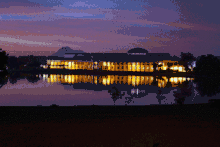
The Sarawak State Library is the major information resource centre and provides information services for the public and private sectors.[123] The library serves Kuching and its outskirts as the main depository of public records. In addition, it administers, monitors, and facilitates the operations of 36 village libraries in the state funded by the National Library of Malaysia.[124]
Other public libraries in Kuching include the DBKU City Library[125] and village libraries such as in Bandar Baru Samariang, Kampung Samariang Lama, and Taman Sepakat Jaya.
Culture and leisure
Attractions and recreation spots
Cultural
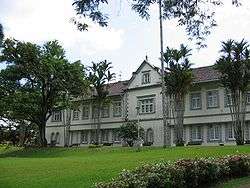
Kuching maintains several museums showcasing its culture and history. The Sarawak State Museum, is one of the finest museums in Asia and known as Kuching's oldest and most historical building, which exhibits collections of the indigenous races in Sarawak.[127][128][129] Directly opposite the Sarawak Museum is the Tun Abdul Razak Hall which serves as an exhibition venue and the office of the Sarawak Museum Department. While located right behind the hall is the Islamic Heritage Museum.
Other museums in Kuching include the Chinese History Museum, Kuching Cat Museum, Sarawak Timber Museum and Textile Museum Sarawak. Kuching is also home to the first ever planetarium in Malaysia,[130] the Sultan Iskandar Planetarium which adjacent to the Kuching Civic Centre.
Historical
Interesting historical landmarks and sites of Kuching include The Astana (the former palace of the White Rajahs and currently the official residence of the Yang di-Pertua Negeri of Sarawak), and Fort Margherita.
The oldest street of Kuching is the Main Bazaar, a row of 19th century Chinese shophouses located along the Kuching Waterfront overlooking the Sarawak River. It offers the city's best concentration of antique and handicraft shops. The Main Bazaar is part of Kuching's old town, which also includes the Carpenter Street and India Street.[131] The old Courthouse building, which sits in between Carpenter Street and India Street, has undergone major renovation and now houses the Sarawak Tourism Board complex.[132] Some other interesting areas around the central business district include Padungan Street, which is the Chinatown of Kuching.[133] In 2014, calls for the Historic Monuments of Kuching's inclusion in the world heritage list were made public.[134] In 2017, a study was conducted on the possibility of Kuching to be nominated in the world heritage list.[135]
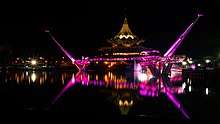
Leisure and conservation areas
A number of leisure spots and conservation areas can be found in Kuching. The Talang-Satang National Park was established with the primary aim of conserving Sarawak's marine turtle population.[136] It covers a total area of approximately 19,400 hectares (47,938 acres), and comprises all lands below the high tide marks on the respective islands.[137] The park also comprises the coastline and sea surrounding four islands of the southwest coast of Sarawak; Talang Besar, Talang Kecil off Sematan, and Satang Besar and Satang Kecil off Santubong, near Kuching.[136] These four "Turtle Islands" are responsible for 95% of all the turtle landings in Sarawak and the park also includes the Tukong Ara-Banun Island Wildlife Sanctuary, two tiny islets which are important nesting sites for colonies of bridled terns and black-naped terns.[137]
Damai, one of Sarawak's main beach resort area, is located on the Santubong Peninsula, about 35 minutes drive from Kuching.[138] The area has sandy beaches at the foot of an imposing jungle-covered mountain. Damai features three world-class resort hotels such as the Damai Beach Resort, Damai Puri Resort and Spa and One Hotel Santubong.[139] Each resort has their own private beach, swimming pool and offers jet-skiing, waterskiing, windsurfing, mountain biking, tennis, squash and fitness centres. There is also an international standard 18-hole golf course designed by the legendary Arnold Palmer located nearby.[140] Other attractions include the Damai Central, Permai Rainforest Resort, Sarawak Cultural Village and the sleepy fishing villages of Santubong and Buntal with their excellent seafood restaurants.[138] While for visitors who like adventurous activities, there is a trekking activity on Mount Santubong.[139]

Aside from that, Damai is also one of the places in Sarawak to see the Irrawaddy dolphin as the mammals can be spotted along the Salak River, Santubong estuary and at the Bako-Buntal Bay.[141] The Santubong Peninsula offers a few sites for bird watching with the BirdLife International Organisation has registered the whole area on Bako-Buntal Bay as an 'Important Bird Area'.[42] Between October and March, the Buntal River becomes an important wintering ground for bird migration.[42] Birds which have been spotted by the Malaysian Nature Society (Kuching Branch) at Buntal include a variety of plovers, sandpipers, egrets, terns, and other rare migrants, while resident birds include collared kingfisher, the white-bellied sea eagle, and brahminy kite.[142]
National parks in Kuching include the Bako National Park[143] and the Kuching Wetlands National Park[144] as well as the Semenggoh Wildlife Centre which operates an orangutan orphanage and rehabilitation program.[145] Also available near Kuching are the Gunung Gading National Park[146] and the Kubah National Park.[147] Located about 40-minutes drive from Kuching is Santubong, a prominent beach resort area home to numerous world-class beach resorts. Other beaches near Kuching are the Lundu Beach and the Sematan Beach.[148] The Borneo Highlands Resort is also nearby, located 1000-metres above sea level.[149]
Other sights
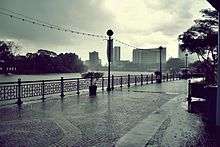

_01.jpg)
The Kuching Waterfront is a 2 kilometre long riverside esplanade stretching from the main hotel and commercial heartland of the city to downtown Kuching.[150] Designed by Sydney architects,[150] the waterfront landscaped is served with food stalls, restaurants, benches and offers an excellent views of the Astana, Fort Margherita, and the New Sarawak State Legislative Assembly Building.[21] The waterfront also features an observation tower, an open-air theatre and musical fountains.[21]
The Kuching Orangutan Murals are vital images of a wheelbarrow filled with eight young orangutans and another baby orangutan swinging from a pipe. It was painted by Ernest Zacharevic along Power Street in the city on 27 April 2014. This latest mural is painted in Zacharevic's usual interactive style, with an actual wheelbarrow sliced into half and secured to the wall to enable the public to take selfies while holding onto the handle. On the other hand, the baby orangutan was painted over a nail on the wall, where people can 'place' items in its hand.[151]
Shopping
Kuching features a number of shopping malls. These include Aeon Kuching Central Mall, VivaCity Megamall, The Spring, Boulevard Shopping Mall, Plaza Merdeka, CityONE Megamall, Kuching Sentral, Emart Lee Ling, Emart Batu Kawa, EG Mall, Giant Petra Jaya Mall, Giant Tabuan Jaya Mall, Giant Kota Padawan Mall, Sarawak Plaza, Tun Jugah, Riverside Shopping Complex, MOYAN SQUARE, Genesis Parade, Green Heights Mall, Wisma Saberkas, and many more.[14] More shopping malls are set to open in the city as construction continues.[14] The Satok Weekend Market is located at Medan Niaga Satok and operated in Saturdays and Sundays. A varieties of vegetables and fruits can be found there including other handicrafts, forest produce (such as wild honey), orchid plants, and a whole range of local snacks and delicacies.[152]
Entertainment
_BHL40563162.jpg)
There are five cinemas located around the city, most of them located inside shopping malls buildings (The Spring, CityONE, VivaCity, Riverside, Summer Mall). Most of the cinemas are owned by either Golden Screen Cinemas, MBO Cinemas, Lotus Five Star and TGV Cinemas.[153] Bookaroo, a children's literature festival, travelled from India to Kuching since 2016 and takes place in April on the city every year to featuring the Bookaroo Kuching Fest. The festival invites authors, illustrators, storytellers, and performers from all over the world, urging children to bring books with them.[154][155]
Music
Since 1997, Kuching has been host to the Rainforest World Music Festival (RWMF), an annual music festival which brings performers and spectators to the region from all over the world. Hosted by the Sarawak Cultural Village near the Mount Santubong, the festival is now one of the largest musical events in Malaysia.[156][157][158] RWMF had been voted as Top 25 Best International Festivals by the British-based magazine Songlines.[159]
Radio stations
Music radio station set up in Sarawak is Radio Klasik FM (87.6), Nasional FM (88.1), Sarawak FM (88.9), TraXX FM (89.9), Ai FM (90.7), Cats FM (99.3), Hot FM (94.3), Hitz (95.3), Era (96.1), My (96.9), Mix (97.7), One FM (98.3), Lite Sarawak (100.1), Bernama Radio (100.9), Sinar (102.1) and Melody (103.7).
International relations
Several countries have set up their consulates in Kuching, including Australia,[160] Brunei,[161] China,[162] Denmark,[163] France,[164] Indonesia,[165] Poland[166] and the United Kingdom.[167]
Sister cities
Kuching currently has ten sister cities:
See also
- Archdiocese of Kuching
- Greater Kuching
- Kuching Heroes Cemetery
- List of roads in Kuching
References
- "Briefing By The Mayor of Kuching North". Kuching North City Hall. Economic Planning Unit (Prime Minister's Department Malaysia). Archived from the original on 19 December 2013. Retrieved 19 December 2013.
- "Kuching, Malaysia - Weather History and Climate Data". World Climate. Archived from the original on 1 December 2014. Retrieved 28 March 2015.
- "Malaysia Elevation Map (Elevation of Kuching)". Flood Map : Water Level Elevation Map. Archived from the original on 22 August 2015. Retrieved 22 August 2015.
- Kit, Lee Yu (20 January 2007). "Scaling Santubong". The Star (Malaysia). Retrieved 28 March 2015.
- "Malaysia Population 2019". World Population Review. 4 February 2019. Retrieved 19 April 2019.
- "Population Distribution by Local Authority Areas and Mukims, 2010" (PDF). Statistics Department, Malaysia. December 2011. Archived from the original (PDF) on 14 November 2014. Retrieved 19 July 2013.
- "City of Kuching Ordinance" (PDF). Sarawak State Attorney-General's Chambers. 1988. p. 3 (Chapter 48).
- Oxford Business Group. The Report: Sarawak 2011. Oxford Business Group. pp. 13–. ISBN 978-1-907065-47-7. Retrieved 18 July 2013.
- "Population Distribution by Local Authority Areas and Mukims, 2010 (page 1 & 8)" (PDF). Department of Statistics, Malaysia. Archived from the original (PDF) on 5 February 2015. Retrieved 19 July 2013.
- Trudy Ring; Robert M. Salkin; Sharon La Boda (January 1996). International Dictionary of Historic Places: Asia and Oceania. Taylor & Francis. pp. 497–498. ISBN 978-1-884964-04-6.
- Christina Umpi (2011). "A review of the centralized sewerage system for Kuching City" (PDF). Faculty of Engineering. Universiti Malaysia Sarawak. Archived from the original (PDF) on 31 December 2017. Retrieved 31 December 2017.
- John Brunton (21 January 2017). "Kuching, Malaysia: what to see plus the best restaurants, hotels and bars". The Guardian. Archived from the original on 31 December 2017. Retrieved 31 December 2017.
- Raymond Frederick Watters; T. G. McGee (1997). Asia-Pacific: New Geographies of the Pacific Rim. Hurst & Company. pp. 311–. ISBN 978-1-85065-321-9.
- Oxford Business Group (2008). The Report: Sarawak 2008. Oxford Business Group. pp. 30, 56, 69 & 136. ISBN 978-1-902339-95-5.
- Trudy Ring; Noelle Watson; Paul Schellinger (12 November 2012). Asia and Oceania: International Dictionary of Historic Places. Routledge. pp. 866–. ISBN 978-1-136-63979-1. Retrieved 18 July 2013.
- "Origin of Name - Kuching". Asia Tourism Alliance. Archived from the original on 4 February 2015. Retrieved 4 February 2015.
- Rowthorn C, Cohen M, Williams C. (2008). In Borneo. Ediz. Inglese. Lonely Planet. p. 162. Google Book Search. Retrieved 4 February 2015.
- Paulo Alcazaren (17 September 2011). "Truly cool Kuching". The Philippine Star. Archived from the original on 6 June 2014. Retrieved 6 June 2014.
- Sarawak Museum (1993). A brief history of Kuching. Sarawak Museum.
- Francis Chan, The Borneo Post, 1 September 2013
- Pat Foh Chang (1999). Legends and History of Sarawak. Chang Pat Foh. ISBN 978-983-9475-06-7. Retrieved 13 July 2012.
- Faisal S. Hazis; Mohd. Faisal Syam Abdol Hazis (2012). Domination and Contestation: Muslim Bumiputera Politics in Sarawak. Institute of Southeast Asian Studies. pp. 5–25–26–29. ISBN 978-981-4311-58-8. Retrieved 18 July 2013.
- Borneo. Ediz. Inglese. Lonely Planet. 2008. pp. 162–. ISBN 978-1-74059-105-8. Retrieved 18 July 2013.
- Margaret Brooke (January 2010). My Life in Sarawak. General Books LLC. ISBN 978-1-152-19241-6. Retrieved 18 July 2013.
- Charles De Ledesma; Mark Lewis; Pauline Savage (2003). Malaysia, Singapore and Brunei. Rough Guides. pp. 414–. ISBN 978-1-84353-094-7. Retrieved 18 July 2013.
- Patricia Hului (16 September 2014). "The last goodbye". The Borneo Post Seeds. Archived from the original on 31 December 2017. Retrieved 31 December 2017.
- Steven Runciman (3 February 2011). The White Rajah: A History of Sarawak from 1841 to 1946. Cambridge University Press. pp. 248–. ISBN 978-0-521-12899-5. Retrieved 18 July 2013.
- Patricia Pui Huen Lim; Diana Wong (2000). War and Memory in Malaysia and Singapore. Institute of Southeast Asian Studies. pp. 125–127. ISBN 978-981-230-037-9. Retrieved 18 July 2013.
- "HMAS Kapunda". Royal Australian Navy. Archived from the original on 4 June 2014. Retrieved 4 June 2014.
- Keat Gin Ooi (1 January 2004). Southeast Asia: A Historical Encyclopedia, from Angkor Wat to Timor. R-Z. volume three. ABC-CLIO. pp. 1177–. ISBN 978-1-57607-770-2. Retrieved 18 July 2013.
- Jackson (9 March 2006). British Empire and 2ND Ww (E). Continuum. pp. 445–. ISBN 978-0-8264-4049-5. Retrieved 18 July 2013.
- Keat Gin Ooi (1998). Japanese Empire in the Tropics: Selected Documents and Reports of the Japanese Period in Sarawak, Northwest Borneo, 1941 - 1945. Ohio Univ. Center for Internat. Studies. pp. 6–11. ISBN 978-0-89680-199-8.
- Yvonne Byron (1995). In Place of the Forest; Environmental and Socio-Economic Transformation in Borneo and the Eastern Malay Peninsula. United Nations University Press. pp. 215–. ISBN 978-92-808-0893-3.
- James Stuart Olson; Robert Shadle (1996). Historical Dictionary of the British Empire: A-J. Greenwood Publishing Group. pp. 200–. ISBN 978-0-313-29366-5. Retrieved 18 July 2013.
- Gerard A. Postiglione; Jason Tan (2007). Going to School in East Asia. Greenwood Publishing Group. pp. 210–. ISBN 978-0-313-33633-1. Retrieved 18 July 2013.
- Pat Foh Chang (1999). Legends and history of Sarawak. Chang Pat Foh. ISBN 978-983-9475-07-4. Retrieved 18 July 2013.
- Boon Kheng Cheah (2002). Malaysia: The Making of a Nation. Institute of Southeast Asian Studies. pp. 93–. ISBN 978-981-230-175-8. Retrieved 18 July 2013.
- "History". Council of the City of Kuching South. 14 May 2014. Archived from the original on 15 May 2014. Retrieved 16 May 2014.
- Kuching: towards a new horizon. Kuching Municipal Council. 1988. Retrieved 18 July 2013.
- "Kuching to celebrate new status as 'City of Unity'". The Star (Malaysia). 31 July 2015. Retrieved 31 August 2015.
- Blake, Chen (29 July 2015). "Kuching to be declared world's first 'City of Unity'". Free Malaysia Today. Archived from the original on 22 August 2015. Retrieved 31 August 2015.
- Tamara Thiessen (2012). Borneo: Sabah - Brunei - Sarawak. Bradt Travel Guides. pp. 244–246–266. ISBN 978-1-84162-390-0. Retrieved 20 July 2013.
- Geryl Ogilvy Ruekeith (2 August 2011). "Ex-cop sworn in as Sixth North Kuching Datuk Bandar". The Borneo Post. Archived from the original on 18 May 2014. Retrieved 19 May 2014.
- Jack Wong (29 May 2008). "Chan appointed mayor of Kuching". The Star. Retrieved 19 May 2014.
- "Sarawak : Population By Administrative District 2000 & 2010" (PDF). Sarawak Fact and Figures by State Planning Unit, Chief Minister's Department. Sarawak State Government. 2012. pp. 11/16. Archived from the original (PDF) on 16 October 2014. Retrieved 6 June 2014.
- "Various Studies Aiming To Develop A Better Kuching (Greater Kuching Urban and Regional Study)". Shankland Cox Ltd. Sarawak State Government. Retrieved 6 June 2014.
- Alastair Morrison (1 January 1993). Fair Land Sarawak: Some Recollections of an Expatriate Official. SEAP Publications. pp. 93–. ISBN 978-0-87727-712-5. Retrieved 19 July 2013.
- Thomas Cook. "Venture into Borneo" (PDF). Thomas Cook Tours. Retrieved 10 November 2013.
Borneo has a typically equatorial climate, with temperatures fairly constant throughout the year. (page 17)
- "Kuching, Malaysia Weather History and Climate Data". WorldClimate. Archived from the original on 4 June 2014. Retrieved 28 June 2008.
- "General Climate of Malaysia (Sunshine and Solar Radiation)". Ministry of Science, Technology and Innovation (Malaysia). Archived from the original on 4 June 2014. Retrieved 4 June 2014.
- Doreena Dominick; Mohd Talib Latif; Hafizan Juahir; Ahmad Zaharin Aris; Sharifuddin M. Zain. "An assessment of influence of meteorological factors on PM10 and NO2 at selected stations in Malaysia" (PDF). Department of Environmental Sciences (Universiti Putra Malaysia), Centre of Excellence for Environmental Forensics (Universiti Putra Malaysia), School of Environmental and Natural Resource Sciences (Universiti Kebangsaan Malaysia) and Department of Chemistry (Universiti Malaya). Retrieved 10 November 2013.
- "World Weather Information Service — Kuching". World Meteorological Organisation. Archived from the original on 23 October 2013. Retrieved 7 May 2014.
- "Kuching Climate Normals 1961–1990". National Oceanic and Atmospheric Administration. Retrieved 7 May 2014.
- "Station Kuching" (in French). Météo Climat. Retrieved 14 October 2016.
- "Klimatafel von Kuching / Insel Borneo (Kalimantan) / Malaysia" (PDF). Baseline climate means (1961–1990) from stations all over the world (in German). Deutscher Wetterdienst. Retrieved 17 October 2016.
- Southeast Asian Exports Since the 14th Century: Cloves, Pepper, Coffee, and Sugar. Institute of Southeast Asian. 1 January 1998. pp. 68–. ISBN 978-981-3055-67-4. Retrieved 19 July 2013.
- Tim Huxley (13 September 2013). Disintegrating Indonesia?: Implications for Regional Security. Routledge. pp. 79–. ISBN 978-1-136-04928-6.
- "Keeping tabs on illegal immigrants". New Straits Times. 22 August 1986. p. 6. Retrieved 5 June 2014.
- Judith M. Heimann (1998). The Most Offending Soul Alive: Tom Harrisson and His Remarkable Life. University of Hawaii Press. pp. 270–. ISBN 978-0-8248-2199-9.
- Peter Sibon (8 December 2017). "Bugis in Sarawak also Malaysians — SBA chief". The Borneo Post. Archived from the original on 31 December 2017. Retrieved 31 December 2017.
- Damian Harper (2007). Malaysia, Singapore & Brunei. Ediz. Inglese. Lonely Planet. pp. 339–. ISBN 978-1-74059-708-1. Retrieved 19 July 2013.
- Justin Calderon (14 April 2013). "Tourism through the eyes of Sarawak's 'big village'". Investvine. Retrieved 20 July 2013.
- Idris Aman; Rosniah Mustaffa (2009). "Social Variation Of Malay Language In Kuching, Sarawak, Malaysia: A Study On Accent, Identity And Integration" (PDF). GEMA Online Journal of Language Studies. Faculty of Social Sciences and Humanities (National University of Malaysia). 9 (1): 66. ISSN 1675-8021. Archived from the original (PDF) on 6 June 2014. Retrieved 6 June 2014.
- Paitoon M. Chaiyanara; Sanggam Siahaan; Hilman Pardede; Selviana Napitupulu; Basar Lolo Siahaan; Siska Anggita Situmeang. SIJLL (Singapore International Journal of Language and Literature). LLC Publishing. pp. 149–. ISSN 2251-2829. Retrieved 20 July 2013.
- Richard L. Schwenk (1973). The Potential for Rural Development in the New Seventh Division of Sarawak: A Preliminary Background Report. Institute of Southeast Asian. pp. 18–. GGKEY:NGE9XLE3DRH. Retrieved 20 July 2013.
- Nelson Alcantara (7 February 2014). "Kuching is as easy as ABC". eTurbo News. Retrieved 7 June 2014.
- Heidi Munan (15 October 2009). CultureShock! Borneo: A Survival Guide to Customs and Etiquette. Marshall Cavendish International Asia Pte Ltd. pp. 113–. ISBN 978-981-4484-49-7.
- "Sarawak's Development Plans (Sectoral Shift, 1980 - 2010 ..from Primary to Secondary and Tertiary Sectors)" (PDF). State Planning Unit (Chief Minister's Department). United Nations Development Programme. 2 August 2012. p. 4. Retrieved 7 June 2014.
- "Sarawak State Planning Unit leads the way towards 2020 economic ambitions". Investvine. 19 December 2011. Retrieved 7 June 2014.
- "Industrial Estate by Division". sarawak.gov.my. Official website of the Sarawak Government. Archived from the original on 15 March 2015. Retrieved 3 July 2015.
- "Delegate prospectus". Malaysia Global Business Forum. Archived from the original on 14 March 2012. Retrieved 28 January 2015.
- "Starbucks Coffee the official beverage at youth summit". The Borneo Post. Malaysia. 14 March 2011. Archived from the original on 11 February 2015. Retrieved 28 January 2015.
- "Press release: INTERNATIONAL HYDRO POWER ASSOCIATION TO BRING WORLD CONGRESS TO SARAWAK, BORNEO IN 2013". Bernama. Malaysia. 14 July 2011. Archived from the original on 14 July 2014. Retrieved 28 January 2015.
- "ASEAN Tourism Forum 2014". unwto.org. World Tourism Organization. Archived from the original on 21 March 2015. Retrieved 3 July 2015.
ATF 2014 was held in Kuching in the Malaysian province of Sarawak from the 16th- 23rd of January.
- Tan, Kevin; Ho, Janet (6 February 2014). "500 for Historic Routes Asia Conference". New Sarawak Tribune. Archived from the original on 4 July 2015. Retrieved 3 July 2015.
- "Kuching now a permanent venue for Aiffa". The Borneo Post. Malaysia. 19 June 2014. Archived from the original on 18 August 2014. Retrieved 28 August 2015.
- "Kuching Port celebrated 44th Anniversary". ASEAN Ports Association. Archived from the original on 5 June 2010. Retrieved 21 October 2015.
- "Introduction: Port Information". Kuching Port Authority. Retrieved 21 October 2015.
- "Terminals". Kuching Port Authority. Retrieved 21 October 2015.
- Jonathan Chia (25 July 2013). "New landscaping for oldest roundabout". The Borneo Post. Archived from the original on 8 June 2014. Retrieved 8 June 2014.
- Lawrence Tseu (2006). "URBAN TRANSPORT GROWTH: THE CHALLENGES AHEAD – THE NEW REALISM AND INSTITUTIONAL CHANGES" (PDF). State Planning Unit, Chief Minister’s Office, Sarawak (Fourth Sabah-Sarawak Environmental Convention). Sabah State Government. pp. 11/23. Retrieved 8 June 2014.
- Martin Carvalho; Yuen Meiking; Rahimy Rahim (25 October 2012). "Pan Borneo Highway to be upgraded". The Star. Retrieved 8 June 2014.
- Lonely Planet; Daniel Robinson; Adam Karlin; Paul Stiles (1 May 2013). Lonely Planet Borneo. Lonely Planet. pp. 276–. ISBN 978-1-74321-651-4.
- Jacky (17 March 2014). "Taxi booking app MyTeksi launches in Kuching, one of the most improbable Malaysian city". Vulcan Post. Yahoo! News. Archived from the original on 8 June 2014. Retrieved 8 June 2014.
- Sharon Kong (12 February 2014). "Kuching Sentral system boosts bus companies' sales and revenues". The Borneo Post. Archived from the original on 8 June 2014. Retrieved 8 June 2014.
- "Kuching Bus Terminal". Express Bus Malaysia. Archived from the original on 8 June 2014. Retrieved 8 June 2014.
- "Kuching Sentral". e-tawau. 24 March 2013. Archived from the original on 8 June 2014. Retrieved 8 June 2014.
- John Teo (9 March 2012). "Stand-off over Kuching Sentral". New Straits Times. AsiaOne. Archived from the original on 8 June 2014. Retrieved 8 June 2014.
- Outlook Publishing (September 2008). Outlook Traveller. Outlook Publishing. pp. 69–.
- Sarawak. Jabatan Kerja Raya (1974). Annual Report.
- "Tanah Puteh". The Straits Times. National Library Board. 7 June 1961. p. 8. Retrieved 9 June 2014.
- "About Kuching International Airport". Malaysia Airports Holdings Berhad. Retrieved 28 January 2015.
- "2013 Annual Report" (PDF). Malaysia Airports Holdings Berhad. Archived from the original (PDF) on 20 April 2015. Retrieved 28 January 2015.
- "Malaysia Airlines". Hahn Air. Retrieved 28 January 2015.
- "The Air Asia Family". Air Asia. Retrieved 28 January 2015.
- "MASWings". MASWings. Retrieved 28 January 2015.
- "Kuching Court". Kuching High Court. Archived from the original on 10 June 2014. Retrieved 10 June 2014.
- "KUCHING CITY NORTH - PETRA JAYA" (PDF). Sarawak Property Bulletin. CH Williams Talhar Wong & Yeo Sdn Bhd. July–September 2006. p. 3. Retrieved 10 June 2014.
- "Structure of The Court (STRUCTURE OF THE HIGH COURT IN SABAH & SARAWAK)". The High Court in Sabah and Sarawak. Archived from the original on 30 March 2014. Retrieved 10 June 2014.
- "Name And Address of the State Syariah Judiciary Office". E-Syariah. Archived from the original on 10 June 2014. Retrieved 10 June 2014.
- "Native Courts of Sarawak". Sarawak Native Court. Archived from the original on 10 June 2014. Retrieved 10 June 2014.
- "Alamat Ibu Pejabat Polis Diraja Malaysia (Kuching)". Federal Secretary Office, Sarawak. Archived from the original on 10 June 2014. Retrieved 10 June 2014.
- "Direktori PDRM Sarawak - Kuching" (in Malay). Royal Malaysia Police. Retrieved 1 August 2015.
- "Sarawak aims to recruit 2,280 volunteer reserves by 2017". Federal Secretary Office, Sarawak. 16 November 2014. Archived from the original on 27 February 2015. Retrieved 28 January 2015.
- "Kuching Prison Complex officially opened". The Star. 6 July 2012. Retrieved 10 June 2014.
- "Health in Sarawak". Sarawak State Government. Archived from the original on 10 June 2014. Retrieved 10 June 2014.
- "Hospital Program". Sarawak State Health Department. Archived from the original on 10 June 2014. Retrieved 10 June 2014.
- "History of Sentosa Hospital" (PDF) (in Malay). Sarawak State Health Department. p. 1. Retrieved 10 June 2014.
- "About us (Overview)". Normah Medical Specialist Centre. Archived from the original on 10 June 2014. Retrieved 10 June 2014.
- "About us". Borneo Medical Centre. Archived from the original on 10 June 2014. Retrieved 10 June 2014.
- "Hospitals based in Malaysia". Hospital Directory Asia. Archived from the original on 28 August 2015. Retrieved 28 August 2015.
- "KPJ Healthcare". Kuching Specialist Hospital. Retrieved 10 June 2014.
- "SENARAI SEKOLAH MENENGAH DI NEGERI SARAWAK (List of Secondary Schools in Sarawak) – See Kuching" (PDF). Educational Management Information System. Archived from the original (PDF) on 27 February 2015. Retrieved 9 June 2014.
- "砂拉越华文独中通讯录 (Communication directory of Sarawak Chinese independent schools)" (in Chinese). Archived from the original on 31 December 2013. Retrieved 1 March 2015.
- Tuah, Yvonne (1 July 2013). "Tunku Putra School offers unique education platform in Kuching". The Borneo Post. Archived from the original on 9 May 2015. Retrieved 9 May 2015.
- "Lodge International School celebrates best IGCSE results in school history". New Sarawak Tribune. 31 January 2015. Archived from the original on 9 May 2015. Retrieved 9 May 2015.
- Umpang, Matthew (21 October 2014). "Iconic Sunny Hill a 'time-tested' school". The Borneo Post. Archived from the original on 9 May 2015. Retrieved 9 May 2015.
- Aubrey, Samuel (7 January 2012). "St Joseph's Private Schools open". The Borneo Post. Archived from the original on 15 April 2012. Retrieved 9 May 2015.
- Rudy Rukimin Rambli (5 February 2008). "Samarahan Semakin Pesat Berkembang" (in Malay). Bernama. Archived from the original on 9 June 2014. Retrieved 9 June 2014.
- Yu Ji (1 December 2013). "Striving for two-fold increase". The Star. Archived from the original on 9 June 2014. Retrieved 9 June 2014.
- "PPKS Ilmu buys Inti College facility for RM22mil". The Star. 29 November 2013. Archived from the original on 9 June 2014. Retrieved 9 June 2014.
- "Help realise SCORE dream, technical education institutions urged". The Star. 4 December 2013. Archived from the original on 9 June 2014. Retrieved 9 June 2014.
- "Sarawak State Library: Our Background". Sarawak State Library. Archived from the original on 4 June 2014. Retrieved 4 June 2014.
- "Sarawak State Library: Public Library Services". Sarawak State Library. Archived from the original on 4 June 2014. Retrieved 4 June 2014.
- "Introduction to DBKU city library". librarynet.com.my. Archived from the original on 27 February 2015. Retrieved 28 January 2015.
- "Discover Sarawak Museum's architectural origins". The Borneo Post Seeds. 27 July 2015. Archived from the original on 3 August 2018. Retrieved 3 August 2018.
- Alice Yen Ho (1998). Old Kuching. Oxford University Press. ISBN 978-983-56-0050-0.
- Robert L. Winzeler (January 2004). The Architecture of Life and Death in Borneo. University of Hawaii Press. pp. 160–. ISBN 978-0-8248-2632-1.
- Jan van Harssel; Richard H Jackson; Lloyd E. Hudman (23 January 2014). National Geographic Learning's Visual Geography of Travel and Tourism. Cengage Learning. pp. 530–. ISBN 978-1-305-17647-8.
- Asiatechnology. Review Publishing Company Limited.
- "Main Bazaar and Carpenter Street". Kuching: Sarawak Tourism. Retrieved 7 March 2017.
- "Explore Kuching Heritage in 2 hours". Kuching: Sarawak Tourism. 14 September 2012. Archived from the original on 7 February 2015. Retrieved 7 March 2017.
- Charles de Ledesma; Mark Lewis; Pauline Savage (2000). The Rough Guide to Malaysia, Singapore & Brunei. Rough Guides. ISBN 978-1-85828-565-8.
- "Call for nomination of Kuching Waterfront to become Unesco World Heritage site". The Borneo Post. 19 November 2014. Retrieved 23 January 2019.
- Geryl Ogilvy (30 November 2017). "Improving Kuching's chances of receiving Unesco recognition". The Star. Retrieved 23 January 2019.
- "Talang Satang National Park a sanctuary for endangered turtles". Bernama. The Borneo Post. 20 March 2012. Archived from the original on 6 August 2014. Retrieved 6 August 2014.
- "Talang-Satang National Park". Sarawak Forestry Corporation. Archived from the original on 6 August 2014. Retrieved 6 August 2014.
- "Santubong Peninsula (Damai Beach Resort and its surrounding)". e-tawau. 4 April 2013. Archived from the original on 6 August 2014. Retrieved 6 August 2014.
- Jane Bickersteth; Amanda Hinton (1996). Malaysia & Singapore Handbook. Footprint Handbooks. ISBN 978-0-8442-4909-4.
- "About Damai Golf". Damai Golf and Country Club. Archived from the original on 30 July 2014. Retrieved 6 August 2014.
- Helen Oon (2008). Malaysia. New Holland Publishers. pp. 60–. ISBN 978-1-84537-971-1.
- "Islands and Beaches of Sarawak (Damai Beach, Santubong Peninsula)". e-tawau. 6 August 2013. Archived from the original on 6 August 2014. Retrieved 6 August 2014.
- "Bako National Park". Sarawak forestry cooperation. Archived from the original on 29 January 2015. Retrieved 28 January 2015.
- "Introducing Kuching Wetlands National Park". Lonely Planet. Archived from the original on 11 February 2015. Retrieved 28 January 2015.
- "Semenggoh Wildlife Centre". Sarawak forestry cooperation. Archived from the original on 11 February 2015. Retrieved 28 January 2015.
- "Gunung Gading National Park". Sarawak forestry cooperation. Archived from the original on 4 August 2014. Retrieved 28 January 2015.
- "Kubah National Park". Sarawak forestry cooperation. Archived from the original on 2 December 2013. Retrieved 28 January 2015.
- "Lundu Tourists Attractions is a mixture of nature beauty and sandy beaches". Sarawak -vacations-destinations.com. Archived from the original on 23 June 2013. Retrieved 28 January 2015.
- "Welcome to Borneo Highlands Resort". Borneo Highlands Resort. Archived from the original on 21 January 2015. Retrieved 28 January 2015.
- Craft Arts International. Craft Art Pty. Limited. 1994.
- "Zacharevic moves on to five more masterpieces on Kuching walls". The Borneo Post. 29 April 2014. Retrieved 4 August 2015.
- "Satok Weekend Market". Sarawak Tourism. Retrieved 7 March 2017.
- "TGV to open first cinema in Sarawak next year". The Sun. 28 July 2013. Retrieved 21 December 2015.
- "Bookaroo Festival Kuching 2016". Bookaroo. Archived from the original on 21 April 2017. Retrieved 21 April 2017.
- "Bookaroo Festival Kuching 2017". Bookaroo. Archived from the original on 21 April 2017. Retrieved 21 April 2017.
- "Rainforest World Music Festival - Tips for enjoying the RWMF near Kuching in Sarawak, Borneo". goasia.about.com. Archived from the original on 10 July 2014. Retrieved 28 January 2015.
- "Rainforest World Music Festival - Join tens of thousands of melody-makers and party-goers in the Malaysian jungle for a three day-long celebration of diverse musical styles from around the globe". fest300.com. Archived from the original on 24 October 2014. Retrieved 28 January 2015.
- "7 Biggest Music Festivals in Asia for 2014". asiarooms.com. Archived from the original on 28 August 2014. Retrieved 28 January 2015.
- "RWMF among 25 top festivals". The Star. 8 April 2011. Retrieved 28 January 2015.
- "Australian Consulate in Kuching, Sarawak, Malaysia". Department of Foreign Affairs and Trade, Australia. Retrieved 3 June 2014.
- "Consulate General of Brunei Darussalam in Kuching, Sarawak Malaysia". Ministry of Foreign Affairs and Trade, Brunei. Archived from the original on 6 June 2014. Retrieved 3 June 2014.
- "Chinese Consulate-General in Kuching (Malaysia)". Ministry of Foreign Affairs, China. Retrieved 3 June 2014.
- "Danish Consulates". Ministry of Foreign Affairs, Denmark. Archived from the original on 6 June 2014. Retrieved 3 June 2014.
- "Consulate". Embassy of France in Kuala Lumpur. Archived from the original on 6 June 2014. Retrieved 3 June 2014.
- "Consulate General of the Republic of Indonesia, Kuching". Consulate General of Indonesia, Kuching, Sarawak, Malaysia. Archived from the original on 5 June 2014. Retrieved 4 June 2014.
- "Honorary Consulates in Malaysia" (PDF). European External Action Service. Retrieved 2 June 2013.
- "Supporting British nationals in Malaysia". Government of the United Kingdom. Archived from the original on 14 July 2014. Retrieved 4 June 2014.
Working with local partners and honorary representatives in Penang, Langkawi, Kota Kinabalu and Kuching to assist British nationals
- "DBKU and Bai ethnic group sign letter of intent". The Borneo Post. 7 May 2015. Archived from the original on 8 May 2015. Retrieved 8 May 2015.
- InKunming (20 April 2012). "Kunming and Kuching build sister city relations". en.kunming.cn. Archived from the original on 4 June 2014. Retrieved 9 August 2012.
- Matthew Hoekstra (26 April 2012). "Richmond to become 16th sister of Xiamen". Richmond Review. Archived from the original on 4 June 2014. Retrieved 4 June 2014.
Richmond will be Xiamen's first Canadian sister city and fourth in North America, where Xiamen's other friends are Baltimore, Md., Sarasota, Fla. and Guadalajara, Mexico. Its other sister cities are Cardiff, Wales; Sasebo, Japan; Cebu, Philippines; Wellington, New Zealand; Penang, Malaysia; Marathon, Greece; Sunshine Coast, Australia; Kaunas, Lithuania; Zoetermeer, Netherlands; Kuching, Malaysia; Surabaya, Indonesia; and Mokpo, South Korea.
- "Cities abroad keen to forge ties with Kuching". New Straits Times. 2 August 2012. Archived from the original on 4 June 2014. Retrieved 4 June 2014.
- M Zezen Zainal M (21 September 2019). "Sarawak Malaysia Jajaki Kerjasama Sister City dengan Kota Bandung" [Sarawak Malaysia Establish Sister City Co-operation with Bandung City] (in Indonesian). Bandung Kita. Archived from the original on 26 September 2019. Retrieved 26 September 2019.
- Brilliant Awal (21 September 2019). "Sarawak Malaysia Ajak Kota Bandung Jadi Sister City" [Sarawak Malaysia Invites Bandung City To Become Sister City] (in Indonesian). Gala Media News. Archived from the original on 26 September 2019. Retrieved 26 September 2019.
- Yu Ji (27 August 2011). "Kuching bags one of only two coveted 'Tourist City Award' in Asia". The Star. Retrieved 1 July 2015.
- Rendra Oxtora; Aria Cindyara; Fardah Assegaf (9 July 2019). "Sarawak Chambers explore cooperation with Singkawang". Antara. Archived from the original on 26 September 2019. Retrieved 26 September 2019.
- Eve Sonary Heng (30 August 2012). "MBKS establishes relationship with Korean city". The Borneo Post. Archived from the original on 4 June 2014. Retrieved 4 June 2014.
Notes
- "Mata Kucing is a close relative of Longan (Euphoria longana)" (PDF). Archived from the original (PDF) on 19 March 2014. Retrieved 6 June 2014.
- Mata Kucing is similar to that of Longan fruit.
- Not to be confused with Padawan municipality.
| Wikimedia Commons has media related to Kuching. |
| Wikivoyage has a travel guide for Kuching. |

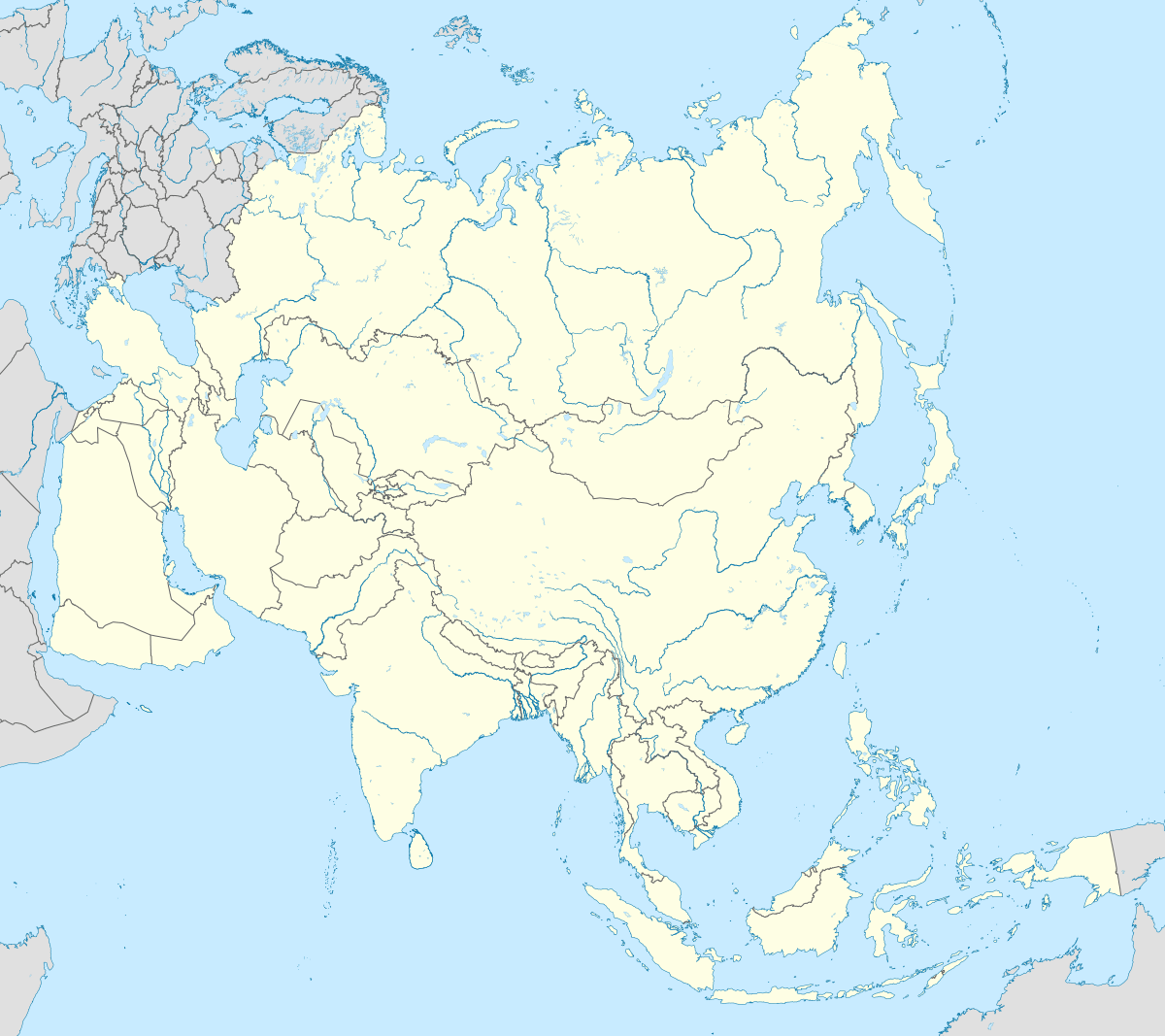
.svg.png)
